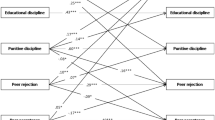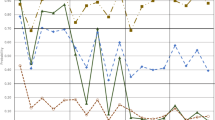Abstract
Alienation from, or involvement in, the social and educational systems of the high school are investigated in an effort to determine the extent that school experiences may influence aggressive and deviant behavior in school and personality styles or orientations. Drawing upon longitudinal data collected from 250 boys followed from grades 8 through 12, potential antecedent-consequence relationships between dimensions of alienation and involvement and these two basic types of student outcomes are examined by cross-lagged panel analyses. Differences between cross-lagged panel correlations provide evidence that student reactions and attachments to school manifest relationships with aggression, deviance, and personality, serving as both antecedents and consequences of these student adaptations. The major findings provide evidence that (1) boys who more frequently break school rules and engage in aggressive or deviant behavior may often come to have more negative attitudes toward school staff and less involvement in school; and (2) student involvement and participation in school life can influence certain aspects of adolescent personality. Possible evidence of reciprocal causation is presented and discussed, as are additional theoretical and methodological implications of the data.
Similar content being viewed by others
References
Anderson, B. D. (1973). School bureaucratization and alienation from high school.Sociol. Educ. 46: 315–344.
Andrews, F. M., and Withey, S. B. (1976).Social Indicators of Well-Being: Americans' Perceptions of Life Quality, Plenum Press, New York.
Beelick, D. B. (1973). Sources of student satisfaction and dissatisfaction.Educ. Res. 67: 19–22.
Blumenkrantz, D. S., and Tapp, J. T. (1977). Alienation and education: A model for empirical study.J. Educ. Res. 71: 104–109.
Brodie, T. A., Jr. (1964). Attitude toward school and academic achievement.Personnel Guid. J. 42: 375–378.
Brookover, W. B., Beady, C., Flood, P., Schweitzer, J., and Wisenbaker, J. (1979).School Systems and Student Achievement, Praeger, New York.
Buxton, C. E. (1973).Adolescents in School, Yale University Press, New Haven, Conn.
Calsyn, R. J., and Kenny, D. A. (1977). Self-concept of ability and perceived evaluation of others: Cause or effect of academic achievement?J. Educ. Psychol. 69: 136–145.
Campbell, A., Converse, P. E., and Rodgers, W. L. (1976).The Quality of American Life: Perceptions, Evaluations, and Satisfactions, Russell Sage, New York.
Campbell, D. T., and Stanley, J. C. (1963).Experimental and Quasi-Experimental Designs for Research, Rand McNally, Chicago.
Cantril, H. (1963) A study of aspirations.Sci. Am. 208: 41–45.
Cobb, S., Brooks, G. H., Kasl, S. V., and Connelly, W. E. (1966). The health of people changing jobs: A description of a longitudinal study.Am. J. Pub. Hlth. 56: 1476–1481.
Coleman, J. S. (ed.) (1974).Youth: Transition to Adulthood, University of Chicago Press, Chicago.
Coleman, J. S. (1975). Methodology and results of the IEA studies of the effects of schools on learning.Rev. Educ. Res. 45: 335–386.
Coleman, J. S., Campbell, E. Q., Hobson, C. J., McPartland, J., Mood, A. M., Weinfeld, F. D., and York, R. L. (1966).Equality of Educational Opportunity, U.S. Government Printing Office, Washington, D.C.
Cook, T. D., and Campbell, D. T. (1979).Quasi-Experimentation: Design and Analysis Issues for Field Settings, Rand McNally, Chicago.
Crano, W. D., and Brewer, M. B. (1973).Principles of Research in Social Psychology, McGraw-Hill, New York.
Crano, W. D., Kenny, D. A., and Campbell, D. T. (1972). Does intelligence cause achievement? A cross-lagged panel analysis.J. Educ. Psychol. 63: 258–275.
Diedrich, R. C., and Jackson, P. W. (1969). Satisfied and dissatisfied students.Personnel Guid. J. 47: 641–648.
Dolan, L. (1978). The affective consequences of home support, instructional quality, and achievement.Urban Educ. 13: 323–344.
Eisert, D. C., and Kahle, L. R. (1982). Self-evaluation and social comparison of physical and role change during adolescence: A longitudinal analysis.Child Dev. 53: 98–104.
Epstein, J. L., and McPartland, J. M. (1976). The concept and measurement of the quality of school life.Am. Educ. Res. J. 13: 15–30.
Gold, M., and Douvan, E. (1969).Adolescent Development: Readings in Research and Theory, Allyn and Bacon, Boston.
Hauser, R. M., Sewell, W. H., and Alwin, D. F. (1976). High school effects on achievement. In Sewell, W. H., Hauser, R. M., and Featherman, D. L. (eds.),Schooling and Achievement in American Society, Academic Press, New York.
Herriott, R. E., and Muse, D. N. (1973). Methodological issues in the study of school effects. In Kerlinger, F. N. (ed.),Review of Research in Education, Vol. 1, F. E. Peacock, Itasca, Ill.
Hirschi, T. (1969).Causes of Delinquency, University of California Press, Berkeley, Calif.
Hoy, W. K. (1972). Dimensions of alienation and characteristics of public high schools.Interchange 3: 38–50.
Jackson, P. W. (1968).Life in Classrooms, Holt, Rinehart and Winston, New York.
Jackson, P. W., and Getzels, J. W. (1959). Psychological health and classroom functioning: A study of dissatisfaction with school among adolescents.J. Educ. Psychol. 50: 295–300.
Jackson, P. W., and LaHaderne, H. M. (1967). Scholastic success and attitude toward school in a population of sixth graders.J. Educ. Psychol. 58: 15–18.
Jencks, C., and Brown, M. D. (1975). Effects of high schools on their students.Harvard Educ. Rev. 45: 275–324.
Jencks, C., Smith, M., Acland, H., Bane, M. J., Cohen, D., Gintis, H., Heyns, B., and Michelson, S. (1972).Inequality: A Reassessment of the Effect of Family and Schooling in America, Basic Books, New York.
Johnston, L. D. (1973).The American High School: Its Social System and Effects, Institute for Social Research, Ann Arbor, Mich.
Kahle, L. R., and Berman, J. J. (1979a). Attitudes cause behaviors: A cross-lagged panel analysis.J. Personal. Soc. Psychol. 37: 315–321.
Kahle, L. R., and Berman, J. J. (1979b). Cross-lagged panel correlation and personality. In Kahle, L. R. (ed.),New Directions for Methodology of Behavioral Science: Methods for Studying Person-Situation Interactions, No. 3, Jossey-Bass, San Francisco.
Kahle, L. R., Kulka, R. A., and Klingel, D. M. (1980). Low adolescent self-esteem leads to multiple interpersonal problems: A test of social adaptation theory.J. Personal. Soc. Psychol. 39: 496–502.
Kahle, L. R., Klingel, D. M., and Kulka, R. A. (1981). A longitudinal study of adolescents' attitude-behavior consistency.Pub. Opin. Quart. 45: 402–414.
Keasey, C. B. (1971). Social participation as a factor in the moral development of preadolescents.Dev. Psychol. 5: 216–220.
Kelly, D. H. (1977). Labeling and the consequences of wearing a delinquent label in a school setting.Education 97: 371–380.
Kelly, D. H., and Pink, W. T. (1973). School commitment, youth rebellion, and delinquency.Criminology 10: 473–485.
Kelly, J. G. (ed.) (1979).Adolescent Boys in High School: A Psychological Study of Coping and Adaption, Lawrence Erlbaum, Hillsdale, N.J.
Kenny, D. A. (1973). Cross-lagged synchronous and common factors in panel data. In Goldberger, A. S., and Duncan, O. D. (eds.),Structural Equation Models in the Social Sciences, Seminar Press, New York.
Kenny, D. A. (1975). Cross-lagged panel correlation: A test for spuriousness.Psychol. Bull. 82: 887–903.
Kenny, D. A. (1978). PANAL: A computer program for panel data analysis. Unpublished manuscript, Department of Psychology, University of Connecticut, Storrs.
Kenny, D. A. (1979).Correlation and Causality, Wiley, New York.
Kenny, D. A., and Campbell, D. T. (in press). Methodological issues in the analysis of temporal data. In Gergen, K., and Gergen, M. (eds.), Historical Social Psychology, Lawrence Erlbaum, Hillsdale, N.J.
Kenny, D. A., and Harackiewicz, J. M. (1979). Cross-lagged panel correlation: Practice and promise.J. Appl. Psychol. 64: 372–379.
Kulka, R. A., Klingel, D. M., and Mann, D. W. (1980). School crime and disruption as a function of student-school fit: An empirical assessment.J. Youth Adoles. 9: 353–370.
Levine, D. M., and Bane, M. J. (eds.) (1975).The “Inequality Controversy”: Schooling and Distributive Justice, Basic Books, New York.
Locksley, A., and Douvan, E. (1979). Problem behavior in adolescents. In Gomberg, E. S., and Franks, V. (eds.),Gender and Disordered Behavior: Sex Differences in Psychopathology, Brunner/Mazel, New York.
McDill, E. L., and Rigsby, L. C. (1973).Structure and Process in Secondary Schools: The Academic Impact of Educational Climates, Johns Hopkins University Press, Baltimore.
Mosteller, F., and Moynihan, D. P. (eds.) (1972).On Equality of Educational Opportunity, Vintage Books, New York.
Newman, B. M. (1975). Characteristics of interpersonal behavior among adolescent boys.J. Youth Adoles. 4: 145–153.
Pelz, D. C., and Andrews, F. M. (1964). Detecting causal priorities in panel study data.Am. Sociol. Rev. 29: 836–848.
Reeves, F. W. (1978). Alienation and the secondary school student.Educ. Rev. 30: 139–148.
Rice, R. R., and Marsh, M. (1979). The social environments of the two high schools: Background data. In Kelly, J. G. (ed.),Adolescent Boys in High School: A Psychological Study of Coping and Adaptation, Lawrence Erlbaum, Somerset, N.J.
Rogosa, D. (1980). A critique of cross-lagged panel correlation.Psychol. Bull. 88: 245–258.
Rosenberg, M. (1965).Society and the Adolescent Self-Image, Princeton University Press, Princeton, N.J.
Rotter, J. B. (1966). Generalized expectancies for internal versus external control of reinforcement.Psychol. Monogr. 80(Whole No. 609).
Rozelle, R. M., and Campbell, D. T. (1969). More plausible rival hypotheses in the cross-lagged panel technique.Psychol. Bull. 71: 74–80.
Schiamberg, L. B. (1973).Adolescent Alienation, Merrill, Columbus, Ohio.
Silberman, C. E. (1970).Crisis in the Classroom, Random House, New York.
Silberman, M. L. (ed.) (1971).The Experience of Schooling, Holt, Rinehart and Winston, New York.
Strauss, G. H. (1974). School as power structure: Student attitudes toward high school policies, student power position, and student rights movement.Educ. Urban Soc. 7: 3–27.
Thomas, C. W., Kreps, G. A., and Cage, R. J. (1977). An application of compliance theory to the study of juvenile delinquency.Sociol. Soc. Res. 61: 157–175.
Van den Berg, S. (1975). Student alienation: Orientations toward and perceptions of aspects of educational social structure.Urban Educ. 10: 262–278.
Yarworth, J. S., and Gauthier, W. J., Jr. (1978). Relationship of student self-concept and selected personal variables to participation in school activities.J. Educ. Psychol. 70: 335–344.
Author information
Authors and Affiliations
Additional information
Received Ph.D. in social psychology from the University of Michigan. Current research interests include survey methodology; alienation and involvement in high school; social roles and mental health; and person-environment fit.
Received Ph.D. in social psychology from the University of Nebraska—Lincoln. Current research interests include attitudes, values, social cognition, and research methodology.
Received M.A. in clinical psychology from the University of Michigan. Current research interests include the development and treatment of aggressive and deviant behavior in adolescence and socialization experiences in high school.
Rights and permissions
About this article
Cite this article
Kulka, R.A., Kahle, L.R. & Klingel, D.M. Aggression, deviance, and personality adaptation as antecedents and consequences of alienation and involvement in high school. J Youth Adolescence 11, 261–279 (1982). https://doi.org/10.1007/BF01537471
Received:
Issue Date:
DOI: https://doi.org/10.1007/BF01537471




